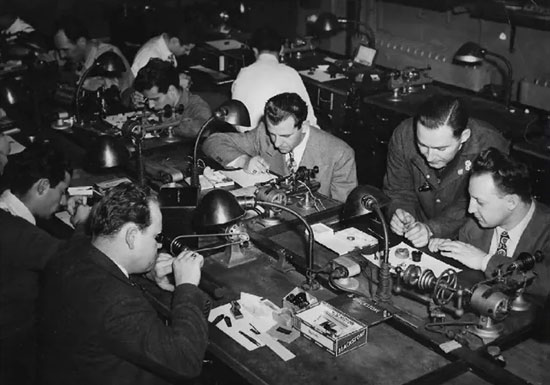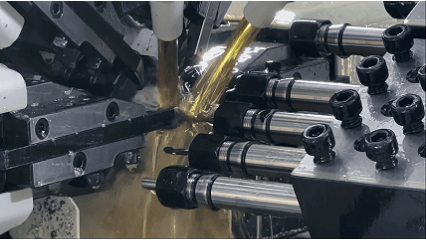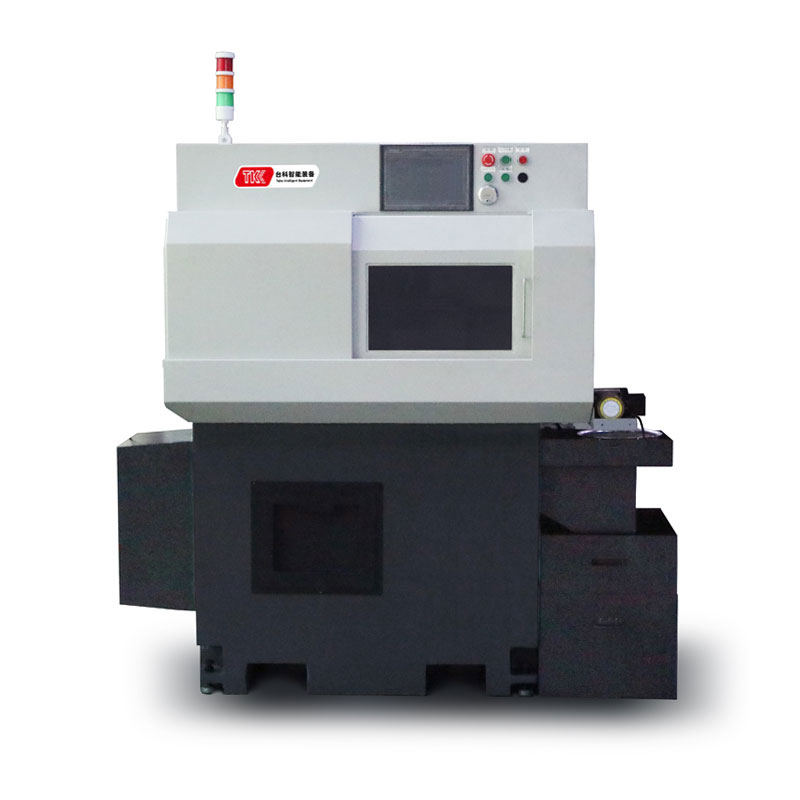What is a cam automatic lathe? What are the advantages and disadvantages compared to a CNC lathe? What are the development trends of machine tools?

A cam automatic lathe is a type of lathe that achieves automated machining based on a cam mechanism. It is further divided into fixed head lathe and sliding headstock lathe.
Ⅰ.Core Principle:
- This is a mechanically automated lathe. Its operational control relies on a precise cam system.
- As the main camshaft rotates, cams with different profiles — through mechanisms such as levers and linkages — precisely and synchronously control the rotation of the spindle, the feeding of the bar stock (typically in an axial direction), and the radial and axial feed movements of various tool slides (including turning, drilling, tapping, and parting-off).
- The profiles of the cams directly determine the sequence and precision of the machining actions. Once properly adjusted, the machine is capable of running continuously and stably for 24 hours.

1.Working Mode:
Fully automatic cycle: Once set up (with cams installed, tools adjusted, and bar stock length set), simply start the machine, and it will automatically and continuously complete feeding, clamping, all machining processes, cutting off the finished part, and ejecting waste material — without manual intervention in each part’s machining cycle.
Multi-tool simultaneous machining: This is one of its most significant features. Multiple tool slides (such as 5, 6, or even more) can perform different machining operations at the same time (for example, one slide turns the outer diameter, one drills a hole, one cuts a groove, and one cuts off the part). This parallel machining greatly improves efficiency.
2.Applicable Scenarios:
- Cam automatic lathes are suitable for processing small parts, with core characteristics being simple structure, regular shape, fixed machining processes, and extremely large production volumes.
- They are especially well-suited for basic lathe operations such as “turning outer diameters, cutting grooves, chamfering, drilling, and tapping.”
- Specific Examples:Mechanical components: Fasteners, screws, mobile phone nuts, pins, rivets, needle rollers, plug pins, connector terminals, charging pins, POGO pins, and other small parts made of relatively soft materials (such as copper, free-cutting iron, aluminum) where precision requirements are not particularly high.


3.Core Advantages:
- Higher Processing Efficiency:Multi-tool Simultaneous Machining: Its most prominent advantage is that multiple tools cut simultaneously, compressing what would normally require multiple processes or tool changes into a single machining cycle. For high-volume production, its output rate is significantly higher than that of conventional CNC lathes using sequential machining.
- Short Non-Cutting Time: There is no need to wait for program instructions. The entire machining cycle (feeding, clamping, all machining operations, cutting off, and ejecting) is highly automated and seamlessly connected, with almost no wasted non-cutting time. A mature cam automatic lathe can produce a small part every few seconds.
- Exceptional machining stability and consistency: The movement of the cams is mandatory and deterministic. Once the machine is properly set up, the motion trajectory generated by each rotation of the cam is completely consistent, unaffected by control system signal delays, servo response fluctuations, or network interference.
- This is crucial for ensuring dimensional consistency of every part during ultra-high-volume production.
- Mature and reliable: The mechanical structure has undergone long-term development and optimization, resulting in a failure rate far lower than that of electronic control systems. It offers stronger long-term operational stability and is extremely durable.
- Low procurement and usage costs:Low initial investment: The structure of a cam lathe is relatively simple, without complex CNC systems, servo motors, or other high-precision electronic components. The equipment price is usually only 1/3 to 1/2 of that of a CNC lathe of the same specification.
- Low maintenance cost: Routine maintenance only requires lubrication and replacement of wear parts (such as cams and tools). There is no need for specialized CNC maintenance personnel, resulting in lower maintenance costs and difficulty.
4.Disadvantages:
- Poor flexibility: Difficult to quickly change machining content; adapting to new products requires redesigning and manufacturing new cams.
- Weak programming capability: Lacks the program control and digital adjustment capabilities of CNC systems. Cam debugging is difficult, requiring skilled technicians to operate, and is hard for beginners to understand.
- Dependence on skilled workers: Due to the outdated nature of the machine itself, there is a gap in technical training and a lack of programming technicians, which are very difficult to recruit. Especially for cam gang-type lathes, if the experienced operator leaves, it may even lead to factory closure.
- Limited complex machining capability: Difficult to machine complex surfaces or irregularly shaped parts.
- Not suitable for low-volume, multi-variety production: High changeover costs and poor cost-effectiveness.
- Poor machining adaptability: Insufficient rigidity makes it difficult to machine high-hardness metals; it is mainly used in industries such as electronics that produce parts from copper, aluminum, and free-cutting steel.
- Low precision: Struggles to meet the machining requirements of high-precision parts with tolerances smaller than 0.01 mm.
5.Development History:
- In 1872, in Switzerland—the “watchmaking kingdom”—engineer Jakob Schweizer invented the first “automatic lathe” equipped with automatic feeding functionality. The birth of this machine marked the official entry of Swiss machine tools into the era of “mechanical automation.”
- In the 1920s, ball screw drive technology was introduced, significantly improving positioning accuracy.
- In the 1950s, hydraulic control systems became widespread, enabling more complex machining actions.
- By the 1970s, Swiss companies such as Tornos were among the first to apply Computer Numerical Control (CNC) technology to automatic lathes, driving their evolution from “mechanical automation” to “digital intelligence.” The introduction of CNC technology was a groundbreaking transformation. It replaced complex cam mechanisms, making programming more flexible, functions more powerful, adjustments quicker, and precision control reach new heights.
- Multi-axis synchronization became possible, and machining complex contours became effortless.

China also experienced a wave of automatic lathe processing.
- In 2006, TAIKE was the first to produce high-precision, stable automatic lathes in Guangdong. The market was extremely hot—machines were in high demand and short supply, with several thousand units sold annually.
- However, as Chinese manufacturing upgraded and product requirements became increasingly demanding, similar to trends in countries like Switzerland and Japan, the market for cam automatic lathes gradually gave way to CNC lathes.
- Currently, the processing range of cam automatic lathes is limited to mid-to-low-end, small, fine parts industries such as electronics and fasteners.
- In response to market feedback, TAIKE has developed more advanced gang-type lathes, as well as cam CNC automatic lathes that combine the advantages of both CNC lathes and automatic lathes.
II. Advantages and Disadvantages Compared to CNC Lathes?
| Comparison Dimension | Cam automatic lathe | VS | CNC machine tool |
| Core Principle | Mechanically cam hard-connected to drive the tool/spindle movement, preset cam profile to control the machining action. | – | The CNC system controls the cutting tool/spindle movement through servo motors + programming (G-code). |
| Applicable Scenario | Single type, ultra-large batch production of standardized parts (such as screws, shafts, pipe joints, etc., with a daily average output of ≥10,000 pieces). | < | Suitable for small-batch production of multiple varieties, complex curved surfaces/irregular parts (such as mold components, custom structural parts, supports frequent production changes). |
| Production Efficiency | The cycle time is extremely short (from a few seconds to sub-second level), running stably 24 hours a day, suitable for “efficiency first” scenarios. | > | Programming and tool change debugging are required for each order, with a relatively long single-piece cycle, but it supports complex machining procedures (such as multi-axis linkage milling). Non-cutting tool movement time is long. |
| Machining Precision | It depends on the manufacturing accuracy of the cam, the accuracy is moderate, generally around ±0.02mm. | < | It relies on the response of the servo system + software calculation, and may produce slight deviations due to thermal deformation/system errors during long-term operation. However, high-precision machine tools can achieve an accuracy of around 0.005mm. |
| Machining Rigidity | Suitable for softer metals (copper, free-cutting iron, aluminum, etc.) 1-25mm in diameter. If the bar diameter is slightly larger, the efficiency may be low due to weak rigidity. | < | Stronger rigidity allows processing of various high-hardness metals. |
| Machining Diameter | Suitable for softer metals (copper, free-cutting iron, aluminum, etc.) 1-25mm in diameter. If the bar diameter is slightly larger, the efficiency may be low due to weak rigidity. | < | With a diameter range of 0.5-400mm, chuck installation is possible, suitable for various materials or irregular parts. |
| Operation Threshold | Although no programming is required, there are currently few technicians engaged in cam automatic lathes, it is difficult to recruit people, young people are not willing to engage in this type of work, the talent is in short supply, and the cam debugging learning period is long, making it difficult to find high-paying talents. | < | Requires skilled operators/programmers; G-code writing and debugging are needed for tool changes. Training programs from colleges provide many candidates, easy recruitment, and moderate salaries. |
| Initial Investment | The basic model price is relatively low (especially for standardized parts scenarios), and the cost performance is high. | > | Higher prices for machines of the same specification, but no additional equipment investment is needed when supporting complex machining |
| Maintenance Cost | Simple structure (cam + guide rail + transmission parts), less maintenance, low cost (only requires regular lubrication/replacement of cams). | > | Relies on precision components such as servo motors and CNC systems, maintenance is complex and costly (requires professional personnel for debugging). |
| Flexibility | It is difficult to adjust the machine, custom cams are required for each product change, and it is not recommended to process miscellaneous parts. Only fixed parts are adapted, and the flexibility is extremely low. | < | Quickly switch machining tasks by modifying programs, support design changes, and have extremely high flexibility. |
| Function Integration Degree | Basic lathe operations such as turning outer diameter, grooving, chamfering, drilling, tapping, etc. | < | Can be equipped with various modular configurations, with powerful processing capabilities and wide applicability. |
| Automated Function | The bar stock is equipped with an automatic feeding device, and vibration plate feeding is rarely used. | < | Multiple non-standard customization methods such as bar feeding machines, vibratory feeders, mechanical pallet racks. |
| Typical Advantageous Scenarios | Mass production of small parts with “low cost and high consistency” (such as hardware standard parts and electronic accessories). Suitable for processing mid-to-low-end, low value-added, high-demand products. | – | Used for small-batch customized production, high-value-added complex curved surface machining, and high-precision parts (such as aerospace components, medical devices). |
Summary:
- The cam automatic lathe is the king of efficiency for mass-producing simple parts, while the CNC lathe is the king of flexibility for complex parts and multi-variety production.
- Both occupy irreplaceable positions in manufacturing. Based on the strengths of these two types of machines, TAIKE has developed a high-efficiency precision machine tool that combines the advantages of both.

- This machine tool integrates the structures of both an automatic lathe and a CNC gang – tool lathe. While retaining the high – efficiency multi – tool simultaneous machining feature of the automatic lathe, the right side adopts the structure of a CNC gang – tool lathe. This allows for more modular configurations and enables more complex machining operations such as turning – milling, slotting, and flat – milling.
- Compared with traditional cam – operated automatic lathes, not only has the accuracy been improved, but also the use of the CNC lathe structure has further enhanced the rigidity. As a result, it can process a wider range of harder metals and more types of materials.
- There is no need to customize cams for each product, which further reduces maintenance and production costs.
- The programming is simple and easy to learn. Beginners can get started within a few days, solving the problem of difficulty in recruiting skilled workers.
- Remote assistance for programming and operation guidance is available, addressing the issue of difficult adjustment and operation of cam – operated automatic lathes.
- The intelligence has been greatly improved, enabling fully automated machining. One operator can manage 20 machines, significantly reducing labor costs.

- If you have hardware parts that need to be evaluated for machining solutions, please contact us.
- We can provide free machining solutions and machining time estimates, and also support sample production!
- You’re welcome to learn about our CNC cam – operated automatic lathe and Swiss – type lathe product series!
👉 Thank you for reading!
👉 Taike As a Swiss-type CNC machine tool manufacturer with 20 years of experience, we specialize in providing precision machining solutions.
👉 For your metal parts requiring machining evaluation, we offer:
✅ Free machining proposals
✅ Machining time estimation
✅ Prototype testing support
👉 Learn about our full range of CNC lathes and Swiss-type lathes now!
👉 Welcome to contact us!





